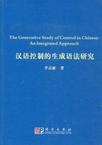汉语控制的生成语法研究
2009-1
科学出版社
李京廉
188
李京廉的博士论文正式出版,这是值得祝贺的事。该书是运用生成语言学的理论来解决汉语语法问题的可贵尝试,为进一步的研讨提供了积极的参考,相信能够引起大家的兴趣。李京廉在山东大学攻读硕士学位时师从胡建华教授专攻生成语言学,写了论“自己”指称问题的句法论文。他来北京师范大学攻读博士学位时,本想继续探讨这一问题,但我认为这个问题大家谈得已经够多,就安排他去探讨汉语语法的其他问题,结果他就把注意力集中到连动句、兼语句等问题上来了。博士毕业后,他又在北京外国语大学中国外语教育研究中心王克非教授指导下从事博士后研究,进一步深入思考这些问题并提炼出新的心得。这种不断进取的精神是可嘉的。 生成语言学虽然是当代语言学的主流和显学,但是它也在不断修正和发展。我和同行翻译过乔姆斯基的著作,但我愧未能亲力投入生成语法的研究。尽管如此,我仍然关注着这个领域的情况。我认为我们应该以兼容并包的态度来看待当代语言学。多年以来,我在研究生教学和论文指导中一直表明我的观点:当代语言学形成了三条路线:结构语言学、功能语言学、认知语言学。结构语言学包括描写结构语言学(老派的结构主义)和解释结构语言学(生成语言学,常自称形式语言学),还有其他流派。功能语言学可以包括结构功能语言学和社会功能语言学。认知语言学是新近崛起的,还没有定论,但不妨认为包括体验主义派和逻辑主义派;当然也有一些人似乎采取中间立场。从另一方面看,我认为认知语言学应该包括认知语义学、认知语法学、认知语用学。很多人不认为“认知语用学”属于认知语言学;这种排斥态度是不必要的。当然一个研究课题(是否应该)属于什么学科范围,本身并无决定性的意义或价值,重要的是一定要在该课题做出成果。不管大家是否同意我的三条路线的说法,大家当然还是可以各走各的路线。不过我觉得,一个人在“我行我素”时偶或转头看一眼别人怎么走路决无任何害处。
《汉语控制的生成语法研究》在生成语法的原则与参数理论框架内对汉语的控制进行研究,即对汉语空主语PRO的分布和释义进行探讨。 PRO的一般出现在非限定小句的主语位置。由于汉语缺乏显性的形态标记,很多学者认为汉语不存在限定与非限定的区分,因此汉语中不存在空语类PRO。 石毓智(1995a)提出时间一维性原则,这一规则在语言中投影为,如果在同一句子中有多个表示同一时间发生的动词,只有一个动词可以具有与表达时间信息有关的语法特征,其他的动词不能。邢欣(1990,1995)也认为虽然汉语缺乏形态特征,但汉语的动词仍然可以分为动态动词和静态动词两类,能带时间限制词“已经”(包括“已”),“正在”(包括“正”、“在”),“将要”(包括“将”、“要”、“就要”)的动词短语是动态短语,不能带这些限制词的动词短语是静态短语。前者可以带时态助词“着”、“了”、“过”,后者不可以。动态动词动词可以单独做谓语,而静态动词短语不可以。 本文认为虽然汉语在形态上不存在限定与非限定的区分,但它可通过词汇手段标记这一区分,并基于以上观点,尝试性地提出区分限定与非限定的标准:在小句中,能够被体副词(aspectual adverbial)“已经(已)”、“正在(正,在)”和“将要(将)”修饰的动词为限定动词,不能被这些体副词修饰的动词为非限定动词。根据这一标准,汉语中的兼语结构、连动结构、动补结构和动词主语结构中存在限定与非限定的区分。值得注意的是,限定从句跟体状语是可选的,有的限定从句因为主句动词的特性而不能跟体状语,但这并不能否定该从句是限定从句,根据以上标准,汉语的兼语结构、连动结构、动词补语结构和动词主语结构存在限定与非限定的区分,PRO出现这些结构中非限定从句的主语位置。 Claomsky(1981)指出,控制理论涉及许多因素,包括结构因素、动词的内在特性以及其他语义和语用考虑。PRO的释义亦如此。基于Choresky(1981)的思路和Pan(1997,1998)提出的邻近条件和相容条件,本文提出了PRO释义的综合理论:PIO选择最近的相容的NP作它的控制语。如果没有最近的、相容的NP,PRO选择较近的、相容的NP作它的控制语。如果没有其他相容的NP,PRO就受隐性控制或任意控制。 经过验证,PRO释义的综合理论能够较好地解释汉语PRO的释义。
序AcknowledgementsAbstract摘要AbbreviationsChapter 1 Introduction1.1 Control Theory: An Overview1.1.1 Definitions of Control1.1.2 Chomskys Typology of Empty Categories1.1.3 Basic Questions Concerning Control1.2 Typology of Control1.2.1 Obligatory Control Versus Non-obligatory Control1.2.2 Subject Control Versus Object Control1.2.3 Split Control Versus Non-split Control1.2.4 Implicit Control1.2.5 Landaus (2000) Typology of Control1.3 Two Generalizations Concerning Control1.3.1 Bachs Generalization1.3.2 Vissers Generalization1.3.3 Intermediate Summary1.4 The Goal of the Book1.5 The Organization of the BookChapter 2 Major Approaches to the Study of Control: A Critical Review2.1 The Study of Control Under the Syntactic Approach2.1.1 The Syntactic Study of Control Under the GB Framework2.1.1.1 Chomskys Study of Control Under the GB Framework2.1.1.2 Manzinis Study of Control Under the GB Framework2.1.1.3 James Huangs Study of Control in Chinese Under the GBFramework2.1.1.4 Battistellas Study of Control in Chinese Under the GB Framework2.1.2 The Syntactic Study of Control Under the MP Framework2.1.2.1 Chomsky and Lasniks Study of Control Under the MP Framework2.1.2.2 Hornsteins Movement Analysis of Control Under the MP Framework2.1.2.3 Manzini and Roussous Study of Control Under the MP Framework2.1.3 The Syntactic Study of Control Under the Framework of Lexical-Functional Grammar2.2 The Study of Control Under the Semantic Approach2.2.1 Thematic Identity Condition and Thematic Distinctness Condition2.2.2 A Lexical-Thematic Theory of Control in Chinese2.2.3 Culicover and Wilkinss Coindexing Rule2.2.4 Sag and Pollards Controller Assignment Principle2.3 The Study of Control Under the Pragmatic Approach2.4 SummaryChapter 3 The Distinction Between Finiteness and Non-finiteness in Chinese3.1 Overview3.2 Proponents of the Finiteness Versus Non-finiteness Distinction in Chinese3.2.1 James Huangs Arguments for the Finiteness Versus Non-finiteness Distinction in Chinese3.2.2 Audrey Lis Arguments for the Finiteness Versus Non-finit-eness Distinction in Chinese3.2.3 Shi Yuzhis Arguments for the Finiteness Versus Non-finit-eness Distinction in Chinese3.3 Opponents of the Finiteness Versus Non-finiteness Distinction in Chinese3.3.1 Xus Arguments Against the Finiteness Versus Non-finitenessDistinction in Chinese3.3.2 Yan Huangs Arguments against the Finiteness Versus Non- finiteness Distinction in Chinese3.3.3 Hu, Pan and Xus Arguments against the Finiteness Versus Non-finiteness Distinction in Chinese3.4 Our Arguments for the Distinction Between Finit- eness and Non-finiteness in Chinese3.4.1 Definitions of Finiteness and Non-finiteness3.4.1.1 The Definitions of Finiteness and Non-finiteness in a Narrow Sense3.4.1.2 The Definitions of Finiteness and Non-finiteness in a Broad Sense3.4.2 A New Criterion for the Distinction Between Finiteness and Non-finiteness in Chinese3.4.3 The Constructions that Distinguish Finiteness from Non-finiteness in Chinese3.4.3.1 The Pivotal Construction3.4.3.2 The Serial Verb Construction3.4.3.3 The Verbal Complement Construction3.4.3.4 The Verbal Subject Construction3.5 SummaryChapter 4 The Distribution and Interpretation of PRO in Chinese: A Tentative Account4.1 The Distribution of PRO in Chinese4.1.1 The Distribution of PRO in the Pivotal Construction4.1.2 The Distribution of PRO in the Serial Verb Construction4.1.3 The Distribution of PRO in the Verbal Complement Construction4.1.4 The Distribution of PRO in the Verbal Subject Construction4.2 The Interpretation of PRO in Chinese4.2.1 The Interpretation of PRO in the Pivotal Construction4.2.2 The Interpretation of PRO in the Serial Verb Construction4.2.3 The Interpretation of PRO in the Verbal Complement Construction4.2.4 The Interpretation of PRO in the Verbal Subject Construction-.4.3 An Integrated Theory for the Interpretation of PRO in Chinese4.4 SummaryChapter 5 Conclusions5.1 Concluding Remarks5.2 Suggestions for Further StudyBibliography
2.2 The Study of Control Under the Semantic Approach In addition to the syntactic study of control the semantic approach is pursued by some scholars such as Ruzicka (1983), Xu (1985-1986), Culicover and Wilkins (1986), and Sag and Pollard (1991). AccordIng to the semantic study of control control is believed to be fundamentally conditioned on the basis of thematic relations as defined along the lines suggested by Fillmore (1968) and Jackendoff (1972, 1987). Jackendoff (1972) argues for a specification of the controller in the lexical entry of the complement-taking verbs as part of the "network of reference", a position also adopted by Chomsky (1980). In an attempt to solve the problem caused by the promise-type verbs for the Rosenbaums MDP or similar analyses, Chomsky proposes an arbitrary feature [+SC] ("assign subject control") to be included in the lexicon of these verbs. As for the second major type of control verb, that is, the persuade-type verbs, Chomsky holds that they should be marked with the arbitrary feature [+CC] ("assign complement control") in the lexicon.
《汉语控制的生成语法研究》在生成语法的原则与参数理论框架内对汉语的控制进行研究,即对汉语空主语PRO的分布和释义进行探讨。《汉语控制的生成语法研究》认为虽然汉语在形态上不存在限定与非限定的区分,但它可通过词汇手段标记这一区分,并基于以上观点,尝试性地提出区分限定与非限定的标准:在小句中,能够被体副词(aspectual adverbial)“已经(已)”、“正在(正,在)”和“将要(将)”修饰的动词为限定动词,不能被这些体副词修饰的动词为非限定动词。根据这一标准,汉语中的兼语结构、连动结构、动补结构和动词主语结构中存在限定与非限定的区分。值得注意的是,限定从句跟体状语是可选的,有的限定从句因为主句动词的特性而不能跟体状语,但这并不能否定该从句是限定从句,根据以上标准,汉语的兼语结构、连动结构、动词补语结构和动词主语结构存在限定与非限定的区分,PRO出现这些结构中非限定从句的主语位置。
